|
TURKISH DELIGHT
Three years and more than a few million dollars later, a fabled residence reopens
BY GAIL SCOTT PHOTOGRAPHY BY GARY LANDSMAN
These are magical times for Turkish Ambassador Nabi Sensoy and his new wife and longtime friend, Gülgün.A recent marriage and a totally refurbished and remodeled residence is ready after more than three years of major architectural restoration and extensive rehabilitation by well-known Washington restoration architect Belinda Reeder and noted embassy interior designer Aniko Gaal Schott.
"We thought we were moving in as early as last August," said Sensoy who, with his bride, has been living out of packing boxes for some weeks. "But this work of great architectural beauty, one of the historic landmarks of Embassy Row," jumped in petite Gülgün, "is also a very precious residence now, really a work of art ... it's a great responsibility for us to make use of this historic property in the best way possible for Turkey."
It is not Sensoy's first luxury posting. "Our embassy residence in Moscow is also a little palace, but it hasn't been redone or restored to this extent," he explained. As a career diplomat, Sensoy has served as Turkey's consul general in London, and has also been Turkey's top envoy to Spain and the Russian Federation.
The magnificent Sheridan Circle Mansion - commissioned by multi-millionaire philanthropist and industrialist Edward Hamlin Everett, who invented the modern corrugated bottle cap - was designed by Washington architect George Oakley Totten, Jr., the respected designer of the University Club and several 16th Street embassy mansions, and importantly, an architect with impressive Turkish ties.
Totten had worked in Istanbul where he acquired an important patron in Sultan Abdul- Hamid, who recognized Totten's talent via his design of the first American embassy there. Totten equally impressed Turkey's then-prime minister Izzet Pasha, who asked the young American to design his own official residence. Totten was eventually offered the exalted position of "personal and private architect to the Sultan." However, it was not meant to be - the Sultan was deposed in 1909 before the partnership could begin.
Returning stateside, bottle-cap mogul Everett commissioned Totten to design and build a mansion for him and his family. His only instructions were "to spend and to dream." Sourcing artisans and materials from all over the world, Totten spent the most of two years, 1914-1915, doing just that. The result was an architectural masterpiece fusing design elements, spanning three centuries and referencing motifs both East and West. Unwittingly, Totten had created the ideal Turkish residence.
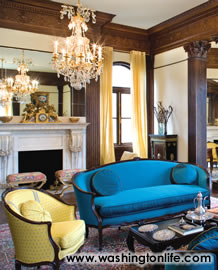 |
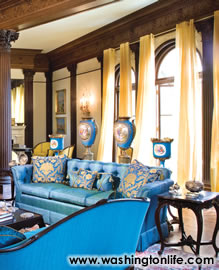 |
| The turquoise and yellow drawing room is now light and airy with silk and linen calm-yellow sheer drapery that let sunlight flood the room. The light also highlights the exquisite antique Sérves vase collection |
a main reason why turquoise has become "the new neutral" for the mansion. Note also the Ambassador's antique silver collection crafted by Turkish silversmiths in Istanbul. |
Realizing this, Everett's wife Grace Burnap approached the Turkish government in 1932, about purchasing the residence after he died in 1929. But Turkey, then a new republic, was anything but wealthy. Instead, the house was leased and in 1936, Mustafa Kemal Atatürk, the visionary founder and the first president of the modern Republic of Turkey, foresaw America's rising global political importance and decided the mansion must be purchased to house the country's ambassador to the U.S. It was bought fully furnished for around $400,000. A true landmark for an important diplomatic relationship had been realized.
The first Turkish ambassador to live in this opulent setting was Münir Ertegün, famous for breaking down Washington's social barriers by holding integrated Sunday music salons arranged by his two sons, Nasuhi and Ahmet. The latter founded Atlantic Records and became a music industry icon [See side-bar]. Until February 1990, the building served as both the Turkish embassy and the ambassadorial residence.
The embassy moved to its current location on Massachusetts Avenue in 1990, but the residence remains Turkey's signature Washington property.
Architect Belinda Reeder of Archetype and her team have been consumed with reclaiming the property's former glory for the past six years. Starting with a feasibility study in 2001 under former Ambassador Baki Ilkin and his wife Nur, Reeder said she knew that it was going to be "a very difficult project." Ultimately, the restoration came to life during the tenure of succeeding Ambassador Faruk Log˜og˜lu and his wife Mimi.
After an intensive search for Totten's original notes and drawings uncovered nothing, Reeder and her team got creative and, carefully, excavated under the heavy stone building with a geo-technical crew. "We found hundreds of big concrete piles that each went down 50 feet," she recalled. "Totten installed the piles for building support for a sandy property that was slanting and eroding down into Rock Creek Park. He rescued and saved this property."
Inside, the tedious restoration of the mansion's 40,000-square-foot interior had also begun. "For the first six months, a team of painters armed with Q-tips did nothing but meticulously take off layers of paint from walls, wood and plaster." In fact, the most extensive part of the restoration is not visible to visitors: "Behind these walls is a whole new house," said Reeder, "There's a completely new electrical and heating and cooling system that can handle 500 people in the hottest, most humid day in August."
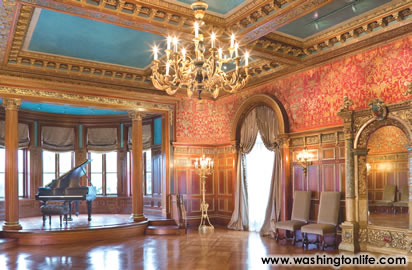 |
| The ballroom was most likely designed around the antique 19th Century red silk tapestry based on 16th Century patterns. The ornate circular latticed doorway and the ornamented vaulted ceiling of gold leaf and turquoise carvings are as spectacular as the original parquet flooring. Pearl grey silk peau-de-soie curtains and matching ballroom chairs complement the red tapestry. |
While Reeder got her hands dirty outside and behind walls, Washington interior designer Aniko Gaal Schott - known for her work in the Hungarian and Dutch residences and ten other embassy properties - was tasked with breathing new life into the interiors.
With turquoise having been chosen as the neutral color, Schott painstakingly set out to locate the right fabrics and exotic trims for the curtains and furniture. She then rearranged original furniture and room settings; en route rediscovering fine objects, which had been, through the years, packed and tucked away. She also oversaw restoration of older items.
"We wanted Turkish colors and textures that flowed naturally, representing furnishings and artwork through the centuries," Schott said, "Yet, we were also creating a contemporary and comfortable home. It was an incredible challenge to meet."
Meanwhile, the Archetype team was busy numbering and labeling each part of the residence's 150 windows and 200 doors - many of which included gold-plated hardware. Reeder filed weekly field reports, keeping track of each and every priceless original artwork, chandelier, brass and glass sconce, and elaborate ironwork. Missing pieces had to be found or created.
Schott's design collaborator Elizabeth Balish followed up on furnishing details, like compiling reports on the restoration and storage of all original rugs and fabrics, wooden case pieces, and antiques. "Although the residence had been refurnished partially and intermittently over the past 40 years, it was in need of a complete and systematic refurbishment," remarked Schott with her trademark flair, "all the paintings, the brass and gilded work were dark brown or black."
Now complete, the current residents feel honored to be there. "With its unique blend of Eastern and Western architectural flourishes, this mansion is the embodiment of Turkey," Sensoy exclaimed as he adjourned to his private quarters. "My wife and I are truly privileged to be the first to occupy the residence following this unprecedented restoration work and look forward to sharing this gift with those who believe in building bridges between our two great nations."
Certainly, they won't be the last ambassadorial couple to feel just as privileged.
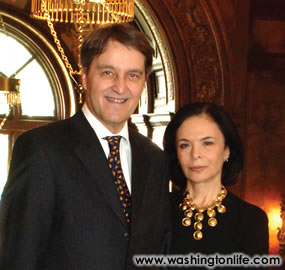 |
| NABI & GÜLGÜN SENSOY |
MEET AMBASSADOR NABI & GÜLGÜN SENSOY
Nabi Sensoy, a career diplomat, and Gülgün Içelli met about 25 years ago in London. They were colleagues then, but moved on to pursue individual careers in different parts of the world. They were always "just friends" until she sent him chocolates on his birthday eleven years ago. Although they lived separate lives, they spent holidays together in Bodrum and Antalya, and cruised along the beautiful Aegean coast with family and close friends.
"In Ankara, we often went out together, and were seen by many of our acquaintances" Gülgün says, "Still, everyone was surprised when we got married. He was the most eligible bachelor in the Turkish Foreign Ministry, so the news of our marriage filled the Turkish papers."
The ambassador, never married before, had always made a home with his late mother and older sister. "In Turkey, we all come from large extended families and I always knew that if I married Nabi, I would naturally be having his family as my own," says Gülgün, a former deputy undersecretary from the Turkish ministry of culture. "Nabi and I make a good team," she adds, "We come from similar backgrounds and have a lot of things in common. I even support his great passion for soccer. The fact that we married later is probably an advantage; we're mature and experienced enough now to fully share our lives."
The news of a bachelor ambassador's appointment to Washington, D.C. surprised a lot of people. "I'll never forget the moment Nabi called," says Gülgün. "He was inVienna, I was at my aunt's summer house in Çesme, near Izmir, sitting by the pool. When he said, 'It's Washington!' All I could say was 'congratulations' and 'best of luck.' But after numerous phone calls and a number of trips between Ankara and Izmir, he finally said, 'I have to discuss something with you' ... I knew what it was." The ambassador interjects: "I never even came close to marrying before, until I met Gülgün. I feel I want to spend the rest of my life with her."
Now married, Ambassador Sensoy feels right at home in the same residence where he served as counselor for the Turkish embassy some 25 years ago. It also helps that he is surrounded by a beautiful collection of Turkish silver and carpets. He points to a beautiful green and gold Turkish carpet and says with pride: "This won America's Magnificent Carpet Award in the High Level Category in 2006. It's an exact replica of Sultan Beyazit II's Kaftan which was displayed in the Style and Status Exhibition at the Sackler and Freer Galleries of Smithsonian Institute. It was donated upon my wife's request by Has Hali in Istanbul, as a gift to this magnificent residence."
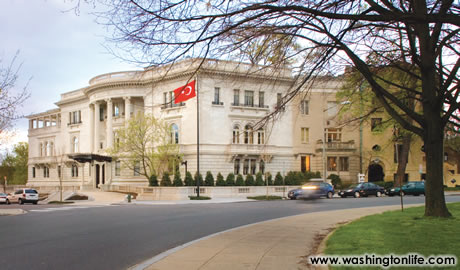 |
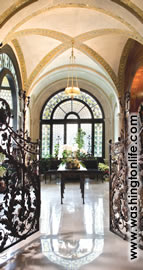 |
| The exterior of the newly refurbished and completely renovated Turkish residence between Sheridan Circle and the Buffalo Bridge overlooking Rock Creek Park is sparkling white with an elaborate bronze and stone marquis. |
The conservatory's signature stained-glass windows, colorful mosaic ceilings, elaborate wrought bronze gate and Art Nouveau furniture make it an ideal venue for small scale entertaining. |
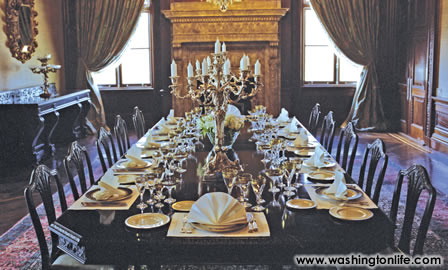 |
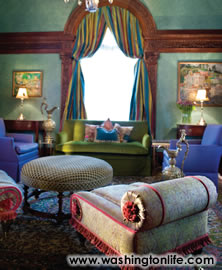 |
| The dining room features Ralph Lauren's woven natural fiber wall coverings, a magnificent bronze and silver Balthazar clock (not shown), three silver and crystal chandeliers (not shown), and silver 18th Century Epernay's and eight-arm candelabras atop the original Hepplewhite dining table (Photo by Russel Hirschon). |
The centerpieces of the ottoman room are, appropriately enough, three ottomans (Tulips courtesy of Ultra Violet florist) |
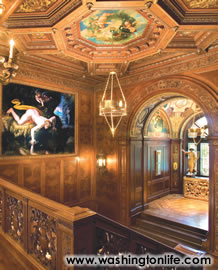 |
| Looking out over the magnificent sweeping double staircase from the second floor Reception Hall, you see Narcissus looking into the water just before Cupid's arrow is released. On the the opposite wall, a painting of the burning of Troy. These 16th Century paintings are the work Agnolo Bronzino, an Italian Mannerist Painter (1503-1572) and contemporary of Michelangelo. The elegant musician's alcove is adorned with stainedglass windows, a carved ceiling with 18th Century gold leaf allegorical paintings and two immaculately restored archangels perched atop a gold leafed chest, each with an arm extended to welcome all visitors with the promise of warm Turkish hospitality. |
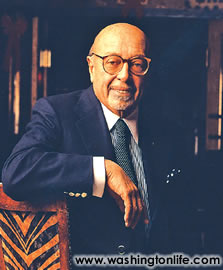 |
| AHMET ERTEGÜN |
ATLANTIC RECORD FOUNDER AHMET ERTEGÜN
Wherever Turkish Ambassador Münir Ertegün and his family lived, there was always music at home. When they moved to Washington D.C. in 1936, his two sons Ahmet and Nasuhi, already had a record collection of 25,000 blues and jazz records. But it was their live Sunday music salons with young Louis Armstrong and Duke Ellington performing to integrated audiences that shocked Washington's elite. Attending prep school during the day, Ahmet and his older brother frequented Washington's musical haunts by night. When their father died in 1944, they both decided to stay in America and pursue musical careers; Nasuhi chose Los Angeles and Ahmet, Washington. With partner Herb Abramson, Ahmet launched Atlantic Records on a $10,000 loan from his Turkish dentist Vahdi Sabit and the rest is history. They recorded some of the greatest musicians of the century, en route changing music forever. He began with Big Joe Turner, Ruth Brown and Ray Charles; discovered Aretha Franklin, Wilson Pickett and Otis Redding; branched out to Bobby Darin, Sonny and Cher, the Bee Gees, and Allman Brothers; and signed the Rolling Stones, Frank Zappa and Kid Rock. In October 2006, Ahmet fell backstage during a Rolling Stones' New York concert and went into a coma. He died on December 14, 2006, at 83.
|

